CLUES模型使用说明书
- 格式:pdf
- 大小:1.39 MB
- 文档页数:53
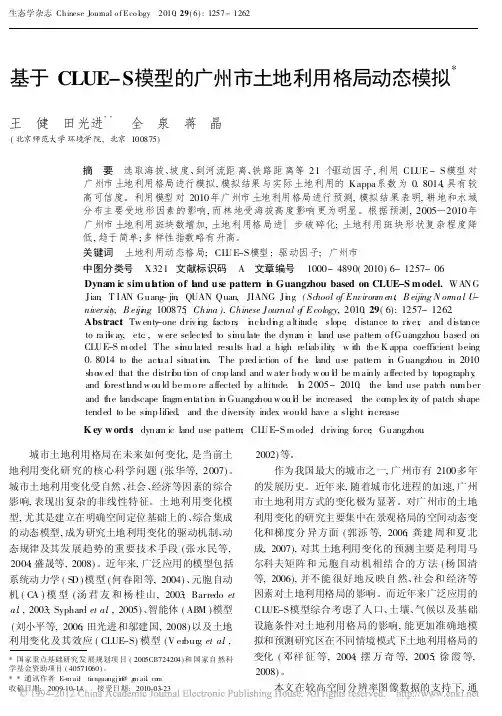
基于CLUE-S 模型的广州市土地利用格局动态模拟*王 健 田光进**全 泉 蒋 晶(北京师范大学环境学院,北京100875)摘 要 选取海拔、坡度、到河流距离、铁路距离等21个驱动因子,利用CLUE -S 模型对广州市土地利用格局进行模拟,模拟结果与实际土地利用的Kappa 系数为0.8014,具有较高可信度。
利用模型对2010年广州市土地利用格局进行预测,模拟结果表明,耕地和水域分布主要受地形因素的影响,而林地受海拔高度影响更为明显。
根据预测,2005)2010年广州市土地利用斑块数增加,土地利用格局进一步破碎化;土地利用斑块形状复杂程度降低,趋于简单;多样性指数略有升高。
关键词 土地利用动态格局;CL UE -S 模型;驱动因子;广州市中图分类号 X321 文献标识码 A 文章编号 1000-4890(2010)6-1257-06Dynam ic sim ul a tion of l a nd use pattern i n Guangzhou based on CLUE-S m odel.WANG Jian ,T IAN Guang -jin ,QUAN Quan,JIANG Ji n g (School of Environm ent ,B eijing N or mal U -niversit y ,B eiji n g 100875,China ).Chinese J ournal o f E cology ,2010,29(6):1257-1262.Abst ract :Tw enty -one driv i n g facto rs ,i n cl u di n g a ltitude ,slope ,distance to ri v er ,and distance to ra il w ay ,etc .,w ere selected to si m u late the dyna m i c land use patter n o fGuangzhou based on CLUE -S m ode.l The si m u lated results had a high reliab ility ,w ith the K appa coefficient being 018014to the act u a l situati o n.The pred iction o f t h e land use pattern i n Guangzhou in 2010sho w ed that the distri b u ti o n of crop land and w ater body w ou l d be m ainly a ffected by topography ,and forestl a nd w ou ld be m o re a ffected by a ltitude .I n 2005-2010,the land use patch nu m ber and the landscape fragm entati o n in Guangzhou w ou l d be increased ,the co mp lex ity of patch shape tended to be si m p lified,and the diversity index would have a sli g ht i n crease .K ey w ords :dyna m ic land use pattern ;CL UE -S m ode;l driving force ;Guangzhou .*国家重点基础研究发展规划项目(2005CB724204)和国家自然科学基金资助项目(40571060)。
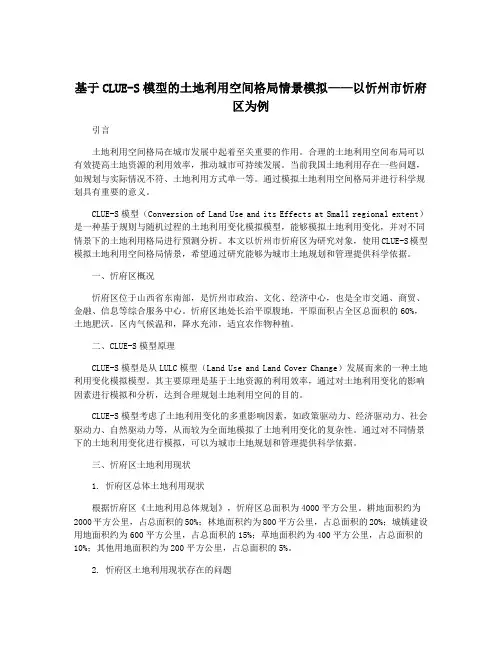
基于CLUE-S模型的土地利用空间格局情景模拟——以忻州市忻府区为例引言土地利用空间格局在城市发展中起着至关重要的作用。
合理的土地利用空间布局可以有效提高土地资源的利用效率,推动城市可持续发展。
当前我国土地利用存在一些问题,如规划与实际情况不符、土地利用方式单一等。
通过模拟土地利用空间格局并进行科学规划具有重要的意义。
CLUE-S模型(Conversion of Land Use and its Effects at Small regional extent)是一种基于规则与随机过程的土地利用变化模拟模型,能够模拟土地利用变化,并对不同情景下的土地利用格局进行预测分析。
本文以忻州市忻府区为研究对象,使用CLUE-S模型模拟土地利用空间格局情景,希望通过研究能够为城市土地规划和管理提供科学依据。
一、忻府区概况忻府区位于山西省东南部,是忻州市政治、文化、经济中心,也是全市交通、商贸、金融、信息等综合服务中心。
忻府区地处长治平原腹地,平原面积占全区总面积的60%,土地肥沃。
区内气候温和,降水充沛,适宜农作物种植。
二、CLUE-S模型原理CLUE-S模型是从LULC模型(Land Use and Land Cover Change)发展而来的一种土地利用变化模拟模型。
其主要原理是基于土地资源的利用效率,通过对土地利用变化的影响因素进行模拟和分析,达到合理规划土地利用空间的目的。
CLUE-S模型考虑了土地利用变化的多重影响因素,如政策驱动力、经济驱动力、社会驱动力、自然驱动力等,从而较为全面地模拟了土地利用变化的复杂性。
通过对不同情景下的土地利用变化进行模拟,可以为城市土地规划和管理提供科学依据。
三、忻府区土地利用现状1. 忻府区总体土地利用现状根据忻府区《土地利用总体规划》,忻府区总面积为4000平方公里。
耕地面积约为2000平方公里,占总面积的50%;林地面积约为800平方公里,占总面积的20%;城镇建设用地面积约为600平方公里,占总面积的15%;草地面积约为400平方公里,占总面积的10%;其他用地面积约为200平方公里,占总面积的5%。

CLUE-S数据操作教程数据处理之前保证所有原始数据的空间参考、范围、栅格大小一致!!!!1、土地利用类型提取将2000、2005、2010年土地利用裁剪为万州区(裁剪之前检查矢量范围是否在人口密度、土地利用、dem、等涉及的范围内,如果边界不统一,可在裁剪之前将矢量边界范围适当缩小一圈,目的是保证后面所有栅格的范围一致),将土地利用类型的1、2、3、4、5、6重分类为0、1、2、3、4、5(clues软件要求从0开始),然后分别提取各类型(有该种类型赋值为1,无该种类型赋值为0)再转为ASCII(各个类型转分别转一个ASCII,总的转一个ASCII,三年共6*3+1*3=21个ASCII文件,起始年的ASCII文件命名为cov_all.0)。
检查ASCII文件的行列号、XY坐标是否一致。
按掩膜提取是要把环境范围选为作为掩膜的栅格cov_all.0用6中土地利用类型直接转,其余单独种类Con("2005年土地rec.tif" == 0,1,0)若con函数报错,用重分类也可以实现2、驱动因子(驱动因子不需要归一化)2.1道路因子(欧氏距离)道路-欧氏距离-转栅格-掩膜(裁剪)-转为ASCII2.2河流因子(欧氏距离)同2.12.3乡镇点因子(欧氏距离)同2.12.4自然村因子(欧氏距离)同2.1注意:做欧氏距离时,环境设置要把范围设置为与边界相同,再用土地利用的栅格掩膜,保证裁剪出来的行列号一致2.5人口密度(人口空间化)2.6 高程Dem-掩膜-转ASCII2.7 坡度DEM-坡度-转ASCII3、回归分析3.1转换为单一记录文件所谓 Logistic 回归,是指因变量为二级计分或二类评定的回归分析,在本文中来分析相关的驱动力与某种土地利用类型的相关关系。
分析前,将水域、耕地、建设用地、林地、园地、未利用地六种地类分别从现状图的栅格文件中提取出来,有该种地类的空间位置设为 1,没有该种地类的空间位置设为 0,再转为 ASCII 文件,与 7种驱动力的 ASCII 码文件仪器用模型自带的 File Converter 软件转化为单一记录的文件,在安装目录新建一个“names.txt空文件”结果自动存于stat.txt文件,这样做的目的是剔除空间中不在研究区域内的空值,然后输入到 SPSS 17.0 中,将每种土地利用类型与 7 种驱动力进行回归分析,得出每种驱动力的β值。
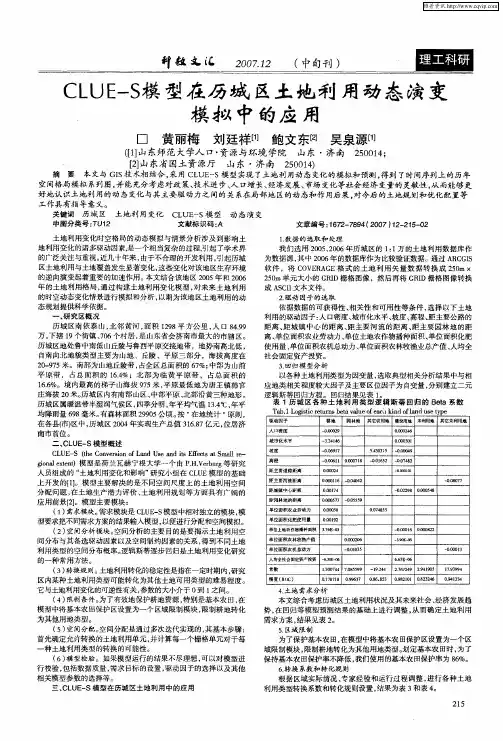

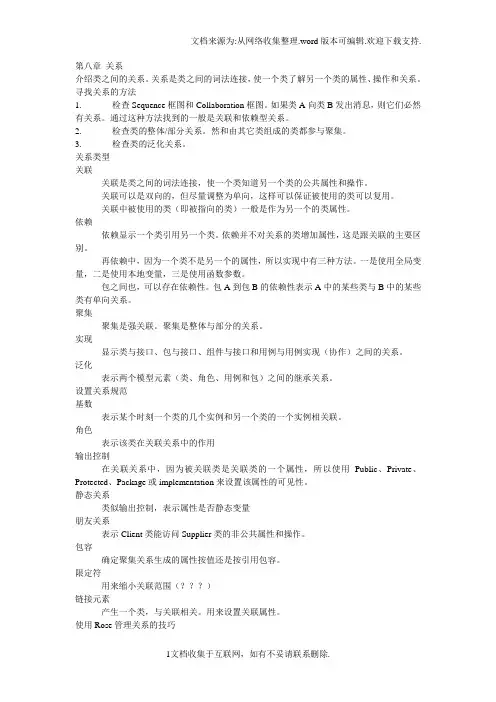
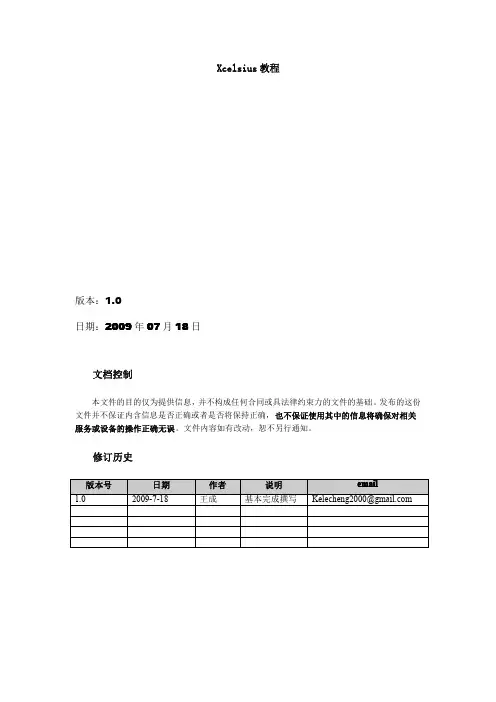
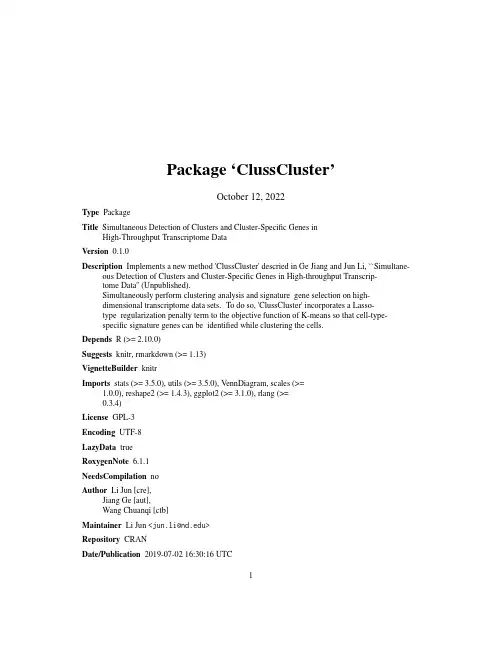
Package‘ClussCluster’October12,2022Type PackageTitle Simultaneous Detection of Clusters and Cluster-Specific Genes inHigh-Throughput Transcriptome DataVersion0.1.0Description Implements a new method'ClussCluster'descried in Ge Jiang and Jun Li,``Simultane-ous Detection of Clusters and Cluster-Specific Genes in High-throughput Transcrip-tome Data''(Unpublished).Simultaneously perform clustering analysis and signature gene selection on high-dimensional transcriptome data sets.To do so,'ClussCluster'incorporates a Lasso-type regularization penalty term to the objective function of K-means so that cell-type-specific signature genes can be identified while clustering the cells.Depends R(>=2.10.0)Suggests knitr,rmarkdown(>=1.13)VignetteBuilder knitrImports stats(>=3.5.0),utils(>=3.5.0),VennDiagram,scales(>=1.0.0),reshape2(>=1.4.3),ggplot2(>=3.1.0),rlang(>=0.3.4)License GPL-3Encoding UTF-8LazyData trueRoxygenNote6.1.1NeedsCompilation noAuthor Li Jun[cre],Jiang Ge[aut],Wang Chuanqi[ctb]Maintainer Li Jun<*************>Repository CRANDate/Publication2019-07-0216:30:16UTC12ClussCluster R topics documented:ClussCluster (2)filter_gene (3)Hou_sim (4)plot_ClussCluster (5)plot_ClussCluster_Gap (6)print_ClussCluster (7)print_ClussCluster_Gap (7)sim_dat (8)Index9 ClussCluster Performs simultaneous detection of cell types and cell-type-specificsignature genesDescriptionClussCluster takes the single-cell transcriptome data and returns an object containing cell types and type-specific signature gene setsSelects the tuning parameter in a permutation approach.The tuning parameter controls the L1 bound on w,the feature weights.UsageClussCluster(x,nclust=NULL,centers=NULL,ws=NULL,nepoch.max=10,theta=NULL,seed=1,nstart=20,iter.max=50,verbose=FALSE)ClussCluster_Gap(x,nclust=NULL,B=20,centers=NULL,ws=NULL,nepoch.max=10,theta=NULL,seed=1,nstart=20,iter.max=50,verbose=FALSE)Argumentsx An nxp data matrix.There are n cells and p genes.nclust Number of clusters desired if the cluster centers are not provided.If both are provided,nclust must equal the number of cluster centers.centers A set of initial(distinct)cluster centres if the number of clusters(nclust)is null.If both are provided,the number of cluster centres must equal nclust.ws One or multiple candidate tuning parameters to be evaluated and compared.De-termines the sparsity of the selected genes.Should be greater than1.nepoch.max The maximum number of epochs.In one epoch,each cell will be evaluated to determine if its label needs to be updated.filter_gene3 theta Optional argument.If provided,theta are used as the initial cluster labels of the ClussCluster algorithm;if not,K-means is performed to produce starting clusterlabels.seed This seed is used wherever K-means is used.nstart Argument passed to kmeans.It is the number of random sets used in kmeans.iter.max Argument passed to kmeans.The maximum number of iterations allowed.verbose Print the updates inside every epoch?If TRUE,the updates of cluster label and the value of objective function will be printed out.B Number of permutation samples.DetailsTakes the normalized and log transformed number of reads mapped to genes(e.g.,log(RPKM+1) or log(TPM+1)where RPKM stands for Reads Per Kilobase of transcript per Million mapped reads and TPM stands for transcripts per million)but NOT centered.Valuea list containing the optimal tuning parameter,s,group labels of clustering,theta,and type-specificweights of genes,w.a list containig a vector of candidate tuning parameters,ws,the corresponding values of objectivefunction,O,a matrix of values of objective function for each permuted data and tuning param-eter,O_b,gap statistics and their one standard deviations,Gap and sd.Gap,the result given by ClussCluster,run,the tuning parameters with the largest Gap statistic and within one standard deviation of the largest Gap statistic,bestw and onesd.bestwExamplesdata(Hou_sim)hou.dat<-Hou_sim$xrun.ft<-filter_gene(hou.dat)hou.test<-ClussCluster(run.ft$dat.ft,nclust=3,ws=4,verbose=FALSE)filter_gene Gene FilterDescriptionFilters out genes that are not suitable for differential expression analysis.Usagefilter_gene(dfname,minmean=2,n0prop=0.2,minsd=1)4Hou_simArgumentsdfname name of the expression data frameminmean minimum mean expression for each genen0prop minimum proportion of zero expression(count)for each geneminsd minimum standard deviation of expression for each geneDetailsTakes an expression data frame that has been properly normalized but NOT centered.It returns a list with the slot dat.ft being the data set that satisfies the pre-set thresholds on minumum mean, standard deviation(sd),and proportion of zeros(n0prop)for each gene.If the data has already been centered,one can still apply thefilters of mean and sd but not n0prop. Valuea list containing the data set with genes satisfying the thresholds,dat.ft,the name of dat.ft,andthe indices of those kept genes,index.Examplesdat<-matrix(rnbinom(300*60,mu=2,size=1),300,60)dat_filtered<-filter_gene(dat,minmean=2,n0prop=0.2,minsd=1)Hou_sim A truncated subset of the scRNA-seq expression data set from Hou et.al(2016)DescriptionThis data contains expression levels(normalized and log-transformed)for33cells and100genes. Usagedata(Hou_sim)FormatAn object containing the following variables:x An expression data frame of33HCC cells on100genes.y Numerical group indicator of all cells.gnames Gene names of all genes.snames Cell names of all cells.groups Cell group names.note A simple note of the data set.DetailsThis data contains raw expression levels(log-transformed but not centered)for33HCC cells and 100genes.The33cells belongs to three different subpopulations and exhibited different biological characteristics.For descriptions of how we generated this data,please refer to the paper.Sourcehttps:///geo/query/acc.cgi?acc=GSE65364ReferencesHou,Yu,et al."Single-cell triple omics sequencing reveals genetic,epigenetic,and transcriptomic heterogeneity in hepatocellular carcinomas."Cell research26.3(2016):304-319.Examplesdata(Hou_sim)data<-Hou_sim$xplot_ClussCluster Plots the results of ClussClusterDescriptionPlots the number of signature genes against the tuning parameters if multiple tuning parameters are evaluated in the object.If only one is included,then plot_ClussCluster returns a venn diagram and a heatmap at this particular tuning parameter.Usageplot_ClussCluster(object,m=10,snames=NULL,gnames=NULL,...)top.m.hm(object,m,snames=NULL,gnames=NULL,...)Argumentsobject An object that is obtained by applying the ClussCluster function to the data set.m The number of top signature genes selected to produce the heatmap.snames The names of the cells.gnames The names of the genes...Addtional parameters,sent to the methodDetailsTakes the normalized and log transformed number of reads mapped to genes(e.g.,log(RPKM+1) or log(TPM+1)where RPKM stands for Reads Per Kilobase of transcript per Million mapped reads and TPM stands for transcripts per million)but NOT centered.If multiple tuning parameters are evaluated in the object,the number of signature genes is computed for each cluster and is plotted against the tuning parameters.Each color and line type corresponds to a cell type.If only one tuning parameter is evaluated,two plots will be produced.One is the venn diagram of the cell-type-specific genes,the other is the heatmap of the data with the cells and top m signature genes.See more details in the paper.Valuea ggplot2object of the heatmap with top signature genes selected by ClussClusterExamplesdata(Hou_sim)<-ClussCluster(Hou_sim$x,nclust=3,ws=c(2.4,5,8.8))plot_ClussCluster(,m=5,snames=Hou$snames,gnames=Hou$gnames)plot_ClussCluster_Gap Plots the results of ClussCluster_GapDescriptionPlots the gap statistics and number of genes selected as the tuning parameter varies.Usageplot_ClussCluster_Gap(object)Argumentsobject object obtained from ClussCluster_Gap()print_ClussCluster7 print_ClussCluster Prints out the results of ClussClusterDescriptionPrints out the results of ClussClusterUsageprint_ClussCluster(object)Argumentsobject An object that is obtained by applying the ClussCluster function to the data set.print_ClussCluster_GapPrints out the results of ClussCluster_Gap Prints the gap statisticsand number of genes selected for each candidate tuning parameter.DescriptionPrints out the results of ClussCluster_Gap Prints the gap statistics and number of genes selected for each candidate tuning parameter.Usageprint_ClussCluster_Gap(object)Argumentsobject An object that is obtained by applying the ClussCluster_Gap function to the data set.8sim_dat sim_dat A simulated expression data set.DescriptionAn example data set containing expressing levels for60cells and200genes.The60cells belong to4cell types with15cells each.Each cell type is uniquely associated with30signature genes,i.e.,thefirst cell type is associated with thefirst30genes,the second cell type is associated withthe next30genes,so on and so forth.The remaining80genes show indistinct expression patterns among the four cell types and are considered as noise genes.Usagedata(sim_dat)FormatA data frame with60cells on200genes.ValueA simulated dataset used to demonstrate the application of ClussCluster.Examplesdata(sim_dat)head(sim_dat)Index∗datasetsHou_sim,4sim_dat,8ClussCluster,2ClussCluster_Gap(ClussCluster),2filter_gene,3Hou_sim,4plot_ClussCluster,5plot_ClussCluster_Gap,6print_ClussCluster,7print_ClussCluster_Gap,7sim_dat,8top.m.hm(plot_ClussCluster),59。
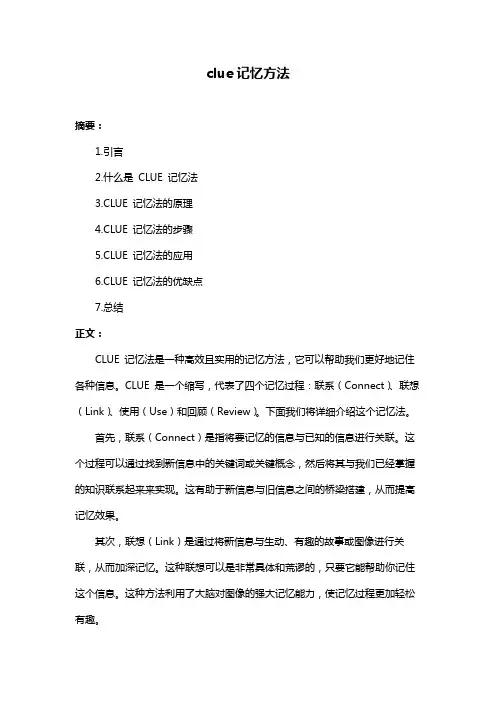
clue记忆方法摘要:1.引言2.什么是CLUE 记忆法3.CLUE 记忆法的原理4.CLUE 记忆法的步骤5.CLUE 记忆法的应用6.CLUE 记忆法的优缺点7.总结正文:CLUE 记忆法是一种高效且实用的记忆方法,它可以帮助我们更好地记住各种信息。
CLUE 是一个缩写,代表了四个记忆过程:联系(Connect)、联想(Link)、使用(Use)和回顾(Review)。
下面我们将详细介绍这个记忆法。
首先,联系(Connect)是指将要记忆的信息与已知的信息进行关联。
这个过程可以通过找到新信息中的关键词或关键概念,然后将其与我们已经掌握的知识联系起来来实现。
这有助于新信息与旧信息之间的桥梁搭建,从而提高记忆效果。
其次,联想(Link)是通过将新信息与生动、有趣的故事或图像进行关联,从而加深记忆。
这种联想可以是非常具体和荒谬的,只要它能帮助你记住这个信息。
这种方法利用了大脑对图像的强大记忆能力,使记忆过程更加轻松有趣。
接下来,使用(Use)是指将新学到的知识应用到实际生活场景中。
通过实际应用,我们可以巩固记忆,并加深对新知识的理解。
这种方法可以提高知识的长期记忆效果。
最后,回顾(Review)是CLUE 记忆法的最后一个环节。
定期回顾所学的内容,可以帮助巩固记忆,确保信息长期存储在大脑中。
通过定期回顾,我们可以发现可能遗忘的知识点,并及时进行补充和巩固。
总的来说,CLUE 记忆法是一种简单且实用的记忆方法。
通过联系、联想、使用和回顾这四个步骤,我们可以大大提高学习和记忆效果。
当然,任何方法都有其优缺点。
CLUE 记忆法的优点在于它利用了大脑对图像和故事的高效记忆能力,使记忆过程更加轻松有趣。
而缺点是这种方法可能需要较长的练习时间,才能熟练掌握。
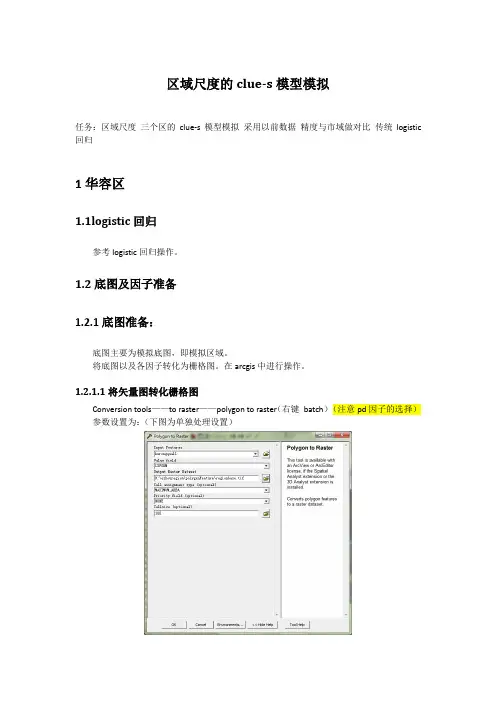
区域尺度的clue-s模型模拟任务:区域尺度三个区的clue-s模型模拟采用以前数据精度与市域做对比传统logistic 回归1华容区1.1logistic回归参考logistic回归操作。
1.2底图及因子准备1.2.1底图准备:底图主要为模拟底图,即模拟区域。
将底图以及各因子转化为栅格图。
在arcgis中进行操作。
1.2.1.1将矢量图转化栅格图Conversion tools——to raster——polygon to raster(右键batch)(注意pd因子的选择)参数设置为:(下图为单独处理设置)其中,Input features 选择你所做的区的矢量文件。
Value field 选择你要栅格化的因子。
Output raster dataset 栅格文件存放的位置保存为tif格式即可。
Cell assigement type 选择maxinum_area 即最大面积作为栅格的属性。
(所有因子都要保持一致)Priority field 选择noneCellsize 选择100.即栅格的大小为100*100. (所有因子都要保持一致)为了防止出错以及方便快捷采用批处理进行栅格化操作。
基本设置和上面一致。
所有因子以及底图。
其中pd以逻辑回归的结果确定有几个参与回归。
转化成栅格图之后,检查一下各因子是否和底图保持一样的形状和大小。
具体方法看边角以及中间缺少的部分是否完全重合。
1.2.1.2 cov_all文件准备栅格图象进行重分类处理。
打开base1(底图)属性表,可以发现LYFSDM和Value值不对应。
需要进行保持一致。
同时记下不同地类栅格的数量(count)。
3D analyst tools——raster reclassly——reclassify只需改reclassification。
方法为LYFSDM减去1作为新的值。
依次填到new values下面。
保存为tif格式。
即可。
重分类之后的结果。
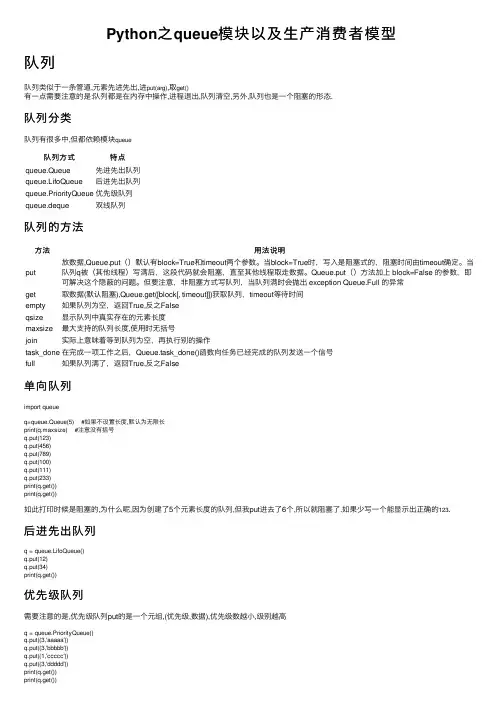
Python之queue模块以及⽣产消费者模型队列队列类似于⼀条管道,元素先进先出,进put(arg),取get()有⼀点需要注意的是:队列都是在内存中操作,进程退出,队列清空,另外,队列也是⼀个阻塞的形态.队列分类队列有很多中,但都依赖模块queue队列⽅式特点queue.Queue先进先出队列queue.LifoQueue后进先出队列queue.PriorityQueue优先级队列queue.deque双线队列队列的⽅法⽅法⽤法说明put 放数据,Queue.put()默认有block=True和timeout两个参数。
当block=True时,写⼊是阻塞式的,阻塞时间由timeout确定。
当队列q被(其他线程)写满后,这段代码就会阻塞,直⾄其他线程取⾛数据。
Queue.put()⽅法加上 block=False 的参数,即可解决这个隐蔽的问题。
但要注意,⾮阻塞⽅式写队列,当队列满时会抛出 exception Queue.Full 的异常get取数据(默认阻塞),Queue.get([block[, timeout]])获取队列,timeout等待时间empty如果队列为空,返回True,反之Falseqsize显⽰队列中真实存在的元素长度maxsize最⼤⽀持的队列长度,使⽤时⽆括号join实际上意味着等到队列为空,再执⾏别的操作task_done在完成⼀项⼯作之后,Queue.task_done()函数向任务已经完成的队列发送⼀个信号full如果队列满了,返回True,反之False单向队列import queueq=queue.Queue(5) #如果不设置长度,默认为⽆限长print(q.maxsize) #注意没有括号q.put(123)q.put(456)q.put(789)q.put(100)q.put(111)q.put(233)print(q.get())print(q.get())如此打印时候是阻塞的,为什么呢,因为创建了5个元素长度的队列,但我put进去了6个,所以就阻塞了.如果少写⼀个能显⽰出正确的123.后进先出队列q = queue.LifoQueue()q.put(12)q.put(34)print(q.get())优先级队列需要注意的是,优先级队列put的是⼀个元组,(优先级,数据),优先级数越⼩,级别越⾼q = queue.PriorityQueue()q.put((3,'aaaaa'))q.put((3,'bbbbb'))q.put((1,'ccccc'))q.put((3,'ddddd'))print(q.get())print(q.get())out:(1, 'ccccc')(3, 'aaaaa')双线队列q = queue.deque()q.append(123)q.append(456)q.appendleft(780)print(q.pop())print(q.popleft())out:456780⽣产消费者模型解决什么问题,使⽤场景从下⾯图中可以发现⽣产者和消费者之间⽤中间类似⼀个队列⼀样的东西串起来。
clue记忆方法(原创版6篇)目录(篇1)1.Clue 记忆方法的背景和起源2.Clue 记忆方法的基本原理3.Clue 记忆方法的具体步骤4.Clue 记忆方法的优点与局限性5.结论:Clue 记忆方法的有效性和实用性正文(篇1)Clue 记忆方法是一种被广泛使用的记忆技巧,起源于古希腊和古罗马时期的记忆术。
它的全称是“Create a Link, Use an Image, Embed it in a Story, Express it with an Emotion”,翻译成中文就是“创建一个链接,使用一个图像,将它嵌入到一个故事中,用情感来表达它”。
Clue 记忆方法的基本原理是通过创建一个有逻辑的联想链条,将需要记忆的信息转化为易于理解和记忆的形象,然后将这些形象嵌入到一个生动的故事中,最后通过情感的表达来加深记忆。
具体操作步骤如下:首先,创建一个链接。
这个链接可以是一个单词,一个短语,或者一个符号,它的作用是将需要记忆的信息与已知的知识联系起来。
其次,使用一个图像。
这个图像可以是任何你能想象出来的形象,只要它能够与链接和你需要记忆的信息联系起来。
然后,将图像嵌入到一个故事中。
这个故事可以是真实发生过的,也可以是你想象出来的,只要它能够生动有趣,能够让你记住这个图像。
最后,用情感来表达这个记忆。
情感可以强化记忆,让你更容易记住这个信息。
Clue 记忆方法的优点在于它能够帮助我们将抽象的信息转化为形象,更容易理解和记忆。
同时,通过将信息嵌入到一个故事中,也能够让我们更容易记住这个信息。
然而,Clue 记忆方法也有其局限性,那就是它需要我们具有一定的想象力和联想能力,对于一些信息可能并不适用。
总的来说,Clue 记忆方法是一种有效且实用的记忆技巧,可以帮助我们提高记忆效率。
目录(篇2)1.CLUE 记忆方法的概述2.CLUE 记忆方法的步骤3.CLUE 记忆方法的优点与应用场景4.结论正文(篇2)CLUE 记忆方法是一种高效的记忆技巧,它的全称是“关联、联想、编码、回顾、扩展”,可以帮助我们更好地记忆各种信息。
基于CLUE-S模型的土地利用空间格局情景模拟——以忻州市忻府区为例作者:朱小林郭青霞来源:《江苏农业科学》2020年第04期摘要:以山西省忻州市忻府区为研究区域,选取海拔、坡度、距公路的距离、距铁路的距离等10个驱动因子,基于忻府区2000年土地利用现状数据,运用CLUE-S模型对2016年的土地利用变化格局进行模拟,通过对比分析发现,模拟效果较好。
在此基础上,通过设置自然增长、耕地保护、生态保护3个情景对2025年忻府区土地利用分布格局进行预测。
结果表明,自然增长情景下,建设用地面积扩张,扩张面积主要围绕着中心城区。
耕地保护情景下,耕地稳定性较高,集中连片分布,耕地数量也较自然增长情况下得到了相应的上升;由于西北方向地势高,不利于浇灌,所以耕地分布较少。
生态保护情景下,林地和草地得到较好的保护,草地在空间上呈现集中连片特征;林地分布比较分散,但大部分也集中在西部区域;地势较高的区域耕地逐渐退为林地和草地;生态保护情景下选取的景观指数聚合度和蔓延度都是最高的。
研究结果可以为管理部门对未来土地可持续利用和土地管理提供一定的参考。
关键词:土地利用变化;CLUE-S模型;Logistic回归模型;情景模拟;忻州市忻府区中图分类号: F301.24文献标志码: A文章编号:1002-1302(2020)04-0254-06收稿日期:2019-06-11基金項目:山西农业大学学术骨干项目(编号:xg201216)。
作者简介:朱小林(1994—),女,山西忻州人,硕士研究生,研究方向为土地利用与规划。
E-mail:1837884296@。
通信作者:郭青霞,博士,教授,硕士生导师,研究方向为土地利用与规划、土地信息技术。
E-mail:gqx696@。
土地利用/覆被变化(LUCC)已变成全球环境变化研究领域的热点问题之一[1-2],其中土地利用变化的研究具有很大的现实意义。
土地利用变化是一个复杂的过程,是受自然、社会、经济等因素在不同的时间、空间尺度上相互作用形成的[3]。
clue模型构建方法
CLUE模型是中文语言理解领域的权威榜单,包含多项测评任务。
其中,语义匹配是一个重要的任务,旨在从语义上衡量两段文本的相关性。
通常来说,语义匹配是一个二分类问题,即两段文本相关或不相关。
CLUE语义匹配榜对文本的相关性进行了进一步的细化,分成了三档,即“0”代表相关程度差,“1”代表有一定相关性,“2”代表非常相关,数字越大表示相关性越高。
此外,CLUE语义匹配数据集也融合了相关性、权威性、内容质量、时效性等维度。
构建CLUE模型的方法可以包括以下步骤:
1. 数据收集:收集大量的文本数据,并对数据进行清洗和预处理。
2. 特征工程:对文本数据进行特征提取和表示,例如使用词袋模型、TF-IDF、N-gram 等方法。
3. 模型选择:选择合适的机器学习模型,例如神经网络、支持向量机、决策树等。
4. 模型训练:使用训练数据对模型进行训练,并对模型进行评估和调优。
5. 模型评估:使用测试数据对模型进行评估,并根据评估结果进行改进和优化。
这些步骤可以根据具体情况进行调整和优化,以构建更准确和高效的CLUE模型。
区域尺度的clue-s模型模拟区域尺度的clue-s模型模拟任务:区域尺度三个区的clue-s模型模拟采⽤以前数据精度与市域做对⽐传统logistic回归1华容区1.1logistic回归参考logistic回归操作。
1.2底图及因⼦准备1.2.1底图准备:底图主要为模拟底图,即模拟区域。
将底图以及各因⼦转化为栅格图。
在arcgis中进⾏操作。
1.2.1.1将⽮量图转化栅格图Conversion tools——to raster——polygon to raster(右键batch)(注意pd因⼦的选择)参数设置为:(下图为单独处理设置)其中,Input features 选择你所做的区的⽮量⽂件。
Value field 选择你要栅格化的因⼦。
Output raster dataset 栅格⽂件存放的位置保存为tif格式即可。
Cell assigement type 选择maxinum_area即最⼤⾯积作为栅格的属性。
(所有因⼦都要保持⼀致)Priority field 选择noneCellsize选择100.即栅格的⼤⼩为100*100.(所有因⼦都要保持⼀致)为了防⽌出错以及⽅便快捷采⽤批处理进⾏栅格化操作。
基本设置和上⾯⼀致。
所有因⼦以及底图。
其中pd以逻辑回归的结果确定有⼏个参与回归。
转化成栅格图之后,检查⼀下各因⼦是否和底图保持⼀样的形状和⼤⼩。
具体⽅法看边⾓以及中间缺少的部分是否完全重合。
1.2.1.2 cov_all⽂件准备栅格图象进⾏重分类处理。
打开base1(底图)属性表,可以发现LYFSDM和Value值不对应。
需要进⾏保持⼀致。
同时记下不同地类栅格的数量(count)。
3D analyst tools——raster reclassly——reclassify只需改reclassification。
⽅法为LYFSDM减去1作为新的值。
依次填到new values下⾯。
保存为tif格式。
clue记忆方法【原创版1篇】目录(篇1)1.CLUE 记忆方法的定义与特点2.CLUE 记忆方法的操作步骤3.CLUE 记忆方法的优点与适用场景4.CLUE 记忆方法的注意事项正文(篇1)CLUE 记忆方法是一种被广泛应用的记忆技巧,其全称为“Create a Link, Understand the Material, Encourage Memory, Review Regularly”。
它是一种通过创建联系、理解材料、激发记忆和定期复习的方式来提高记忆效果的方法。
操作步骤如下:1.Create a Link(创建联系):首先,我们需要将需要记忆的内容与已知的信息进行关联,这样可以帮助我们更容易地记住新知识。
比如,可以将新词与已知的词汇进行关联,或者将抽象的概念与具体的图像进行关联。
2.Understand the Material(理解材料):理解是记忆的基础,我们需要对需要记忆的内容进行深入的理解。
这包括了解知识的背景、含义、用途等信息,这样可以帮助我们更好地记忆和应用知识。
3.Encourage Memory(激发记忆):通过一些记忆技巧,如联想、图像化、故事化等方式,来激发我们的记忆。
这些方法可以帮助我们将抽象的知识转化为形象的图像,从而更容易地进行记忆。
4.Review Regularly(定期复习):记忆是需要不断巩固的,因此,我们需要定期对已学的知识进行复习。
复习可以强化记忆,帮助我们将知识深深地印在脑海中。
CLUE 记忆方法的优点在于,它不仅简单易懂,而且具有很好的实用性。
无论是学习语言、科学知识,还是处理日常事务,都可以运用 CLUE 记忆方法来提高记忆效果。
同时,CLUE 记忆方法的适用场景也非常广泛,无论是学生、职场人士,还是家庭主妇,都可以从中受益。
在使用 CLUE 记忆方法时,有一些注意事项需要我们注意。
首先,我们需要有耐心,记忆是一个长期的过程,需要我们不断地投入时间和精力。